Pork ribs (either St. Saint Louis-style spare ribs or baby back ribs are simple to cook, but it can be hard to tell when they’re done unless you’re a seasoned pit master.
After reading this blog to the end, you’ll know definitively when your pork ribs are done.
You can tell when pork ribs are ready in a number of ways, but different sources may give you different information, leaving you wondering which is the best way to tell.
Which method can you trust? Which one really works? Do you just believe what your coworker says after cooking three racks of ribs and calling themselves a pitmaster?
Do you break a few racks trying to figure it out? It’s embarrassing to say that I may “know someone” who did that and it cost them a lot. There’s no need for any of that, I promise.
Pork ribs are a classic BBQ staple loved by many. When cooked properly, they can be fall-off-the-bone tender and mouthwateringly juicy. However, achieving the ideal texture and moisture requires cooking the ribs to just the right internal temperature. Undercook them and you risk foodborne illness. Overcook them and you’ll end up with dry, chewy ribs. So what’s the perfect internal temp for pork ribs to hit that sweet spot between safety and quality?
Why Internal Temperature Matters
Unlike beef, pork needs to be cooked thoroughly to eliminate the risk of foodborne pathogens. The USDA recommends cooking pork to a minimum safe internal temperature of 145°F. However, for ideal texture, flavor and moisture, ribs should be cooked to a higher temperature.
Cooking ribs to the correct internal temp breaks down the collagen and connective tissue, making the meat fall-off-the-bone tender. It also renders out excess fat, allowing the meat to baste in its own juices. If undercooked the meat will be tough. If overcooked, it will be dry. Only the right temperature produces properly cooked ribs.
Recommended Internal Temperatures
Here are the recommended internal temperature ranges to cook pork ribs to for different levels of doneness:
-
145°F – 160°F – The ribs will be slightly pink with a small amount of juices running clear The meat will be very tender and juicy, This temp is ideal if you prefer ribs cooked medium or medium-rare
-
160°F – 180°F – The ribs will be white throughout with no pink color. Juices will run mostly clear. The meat will be firmer but still moist and tender. This is the ideal temp range for ribs cooked to medium or medium-well doneness.
-
180°F-195°F – The ribs will be fall-off-the-bone tender and may shred with very little pressure. Juices will run clear with some fat rendered out. The meat will be slightly drier but very soft This temp range is ideal for very tender, well done ribs
-
Over 195°F – The ribs will be extremely tender and falling off the bone. However, the meat may be dry and chewy due to excess moisture loss. Pork dries out quickly when cooked over 195°F.
For most people, the ideal internal temperature for pork ribs falls between 165°F-180°F. This ensures the ribs are fully cooked while still retaining moisture and tenderness. Ribs cooked to around 170°F will hit the sweet spot of being perfectly done but not overdone.
How to Tell When Ribs Reach the Right Internal Temp
The most reliable way to determine the internal temperature of ribs is to use an instant read meat thermometer. Insert the probe into the thickest part of the meat, avoiding the bone. Wait 10-15 seconds for the temp reading to stabilize before checking.
Visual indicators can also help determine when ribs are cooked to the right internal temp:
- Meat pulls back from the ends of the bones about 1⁄4 to 1⁄2 inch
- Meat splits cleanly between ribs when twisted with tongs or a fork
- Juices run mostly clear with a tinge of pink (not red)
- Internal color is no longer pink when cut into
Use visual cues in combination with a thermometer for best results. And always verify the internal temp reaches food-safe levels.
Common Pork Rib Temp Mistakes to Avoid
It’s easy to overcook or undercook pork ribs if you don’t monitor the internal temperature. Here are some common mistakes to avoid:
-
Not taking temperature – Cooking by time alone often leads to dry, overcooked meat. Always use a meat thermometer.
-
Inserting thermometer incorrectly – Placing the probe against the bone gives an inaccurate reading. Insert into the meatiest part avoiding bones.
-
Overcooking – Pork dries out quickly when cooked past 195°F. Remove from heat once ribs reach 165-180°F.
-
Undercooking – Stop cooking when ribs reach at least 145°F internally to eliminate foodborne illness risks.
-
Not letting rest – Letting ribs rest 5-10 minutes before cutting allows juices to redistribute for moister meat.
Master the Perfect Ribs Every Time
Achieving fall-off-the-bone tender, juicy pork ribs hinges on cooking to the right internal temperature. For ideal doneness, texture and juiciness, target an internal temp between 165°F-180°F. Use a meat thermometer and utilize visual cues to monitor temperature. Avoid over or undercooking by frequently checking the temp. Mastering the ideal internal temperature will help you serve perfectly cooked ribs every time.
Frequently Asked Questions
What is the minimum safe internal temperature for pork ribs?
The USDA recommends pork ribs reach at least 145°F internally to eliminate bacteria and foodborne illness risks.
Should pork ribs temp be above 175°F?
175°F is an ideal internal temp for ribs to be tender and juicy, but not overcooked. 165°F-180°F is the recommended range. Higher than 180°F risks drying out the meat.
Do pork ribs need to rest after cooking?
Yes, letting pork ribs rest 5-10 minutes allows juices to redistribute so meat stays moist when cut into. Skipping this rest makes the meat dry out faster.
How do you know when ribs are done without a thermometer?
Look for meat shrinking back from bones, clean twisting between ribs, mostly clear juices, and no pink internal color. But thermometers are still highly recommended for accuracy.
Can you eat pork ribs medium rare?
Pork ribs should reach at least 145°F internally to be safe to eat. Temps below 160°F run a higher risk of bacteria. Stick to medium or higher doneness for food safety.
What ribs are best cooked to what temperature?
- Baby back ribs: 170°F-180°F
- Spare ribs: 165°F-175°F
- Country style ribs: 145°F-160°F
This ensures optimal texture and moisture content for each rib type.

At What Temperature Are Pork Ribs Done?
The USDA recommends cooking pork ribs to an internal temperature of 145° F for safety reasons. However, at this temperature the meat is rubbery and tough. Pork internal temp and pork done temp are clearly not the same thing.
Pork ribs aren’t ready to be served until their internal temperature reaches 195° F to 203° F. At this temperature, fat and collagen throughout the meat has broken down and flavored the ribs.
This contributes to the overall taste and texture of the ribs. If the bones peek out and they probe easily at 195° F, I pull them off the grill. There are no bones that stick out if the probe is still tight. I let them heat up to 203° F and then take them off.
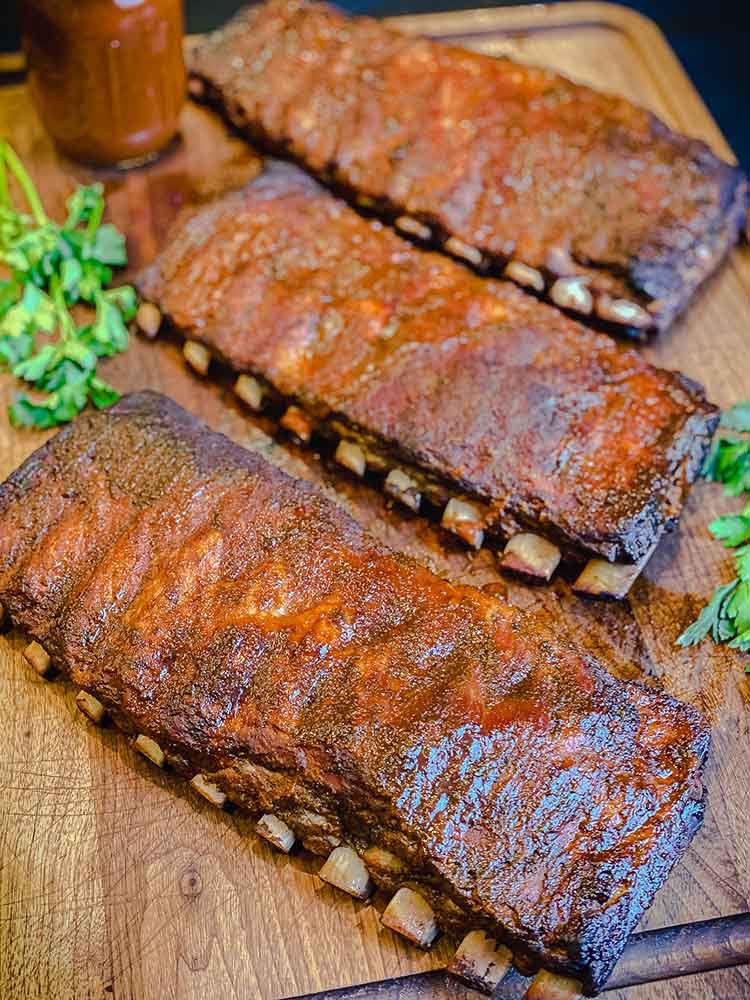
Finally, the meat should keep its shape after biting into it. You may have heard that ribs are perfectly cooked when they “fall off the bone. ” That is actually not true. If the meat falls off the bone, it’s overcooked and has a mushy texture—not ideal for any occasion. The moral of the story is that you should trust a thermometer (like the ThermoWorks Signals or the ThermoWorks Smoke X2 RF) to give you juicy ribs that everyone will want more of!
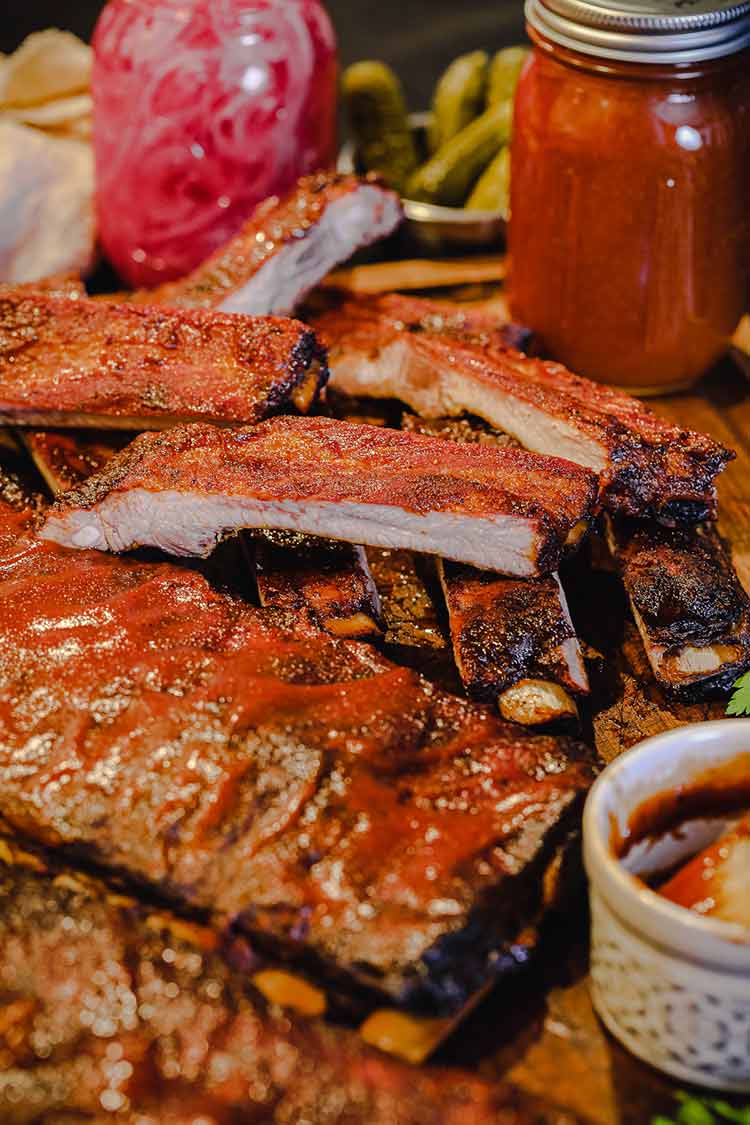
Common Methods for Checking Ribs
Some of the more popular ways of determining if your pork ribs are done include:
- Visual inspection
- Bend test
- Probing
- Bone twisting
- Actually cutting into the ribs (10/10 don’t recommend this one)
- Simply going by time
Some of these work better than others, but non of them are 100% accurate. Don’t worry, though—I’ll explain in more detail how to find out if your pork ribs are done.
The most popular method is looking for the bones to start peeking out. More than a quarter of an inch of bones will start to stick out along the slab, which is called “pull back.” That’s usually a pretty good indication that the ribs are about ready.
We’re not saying it’s 100% accurate, but it’s a simple visual clue that only needs a quick glance.
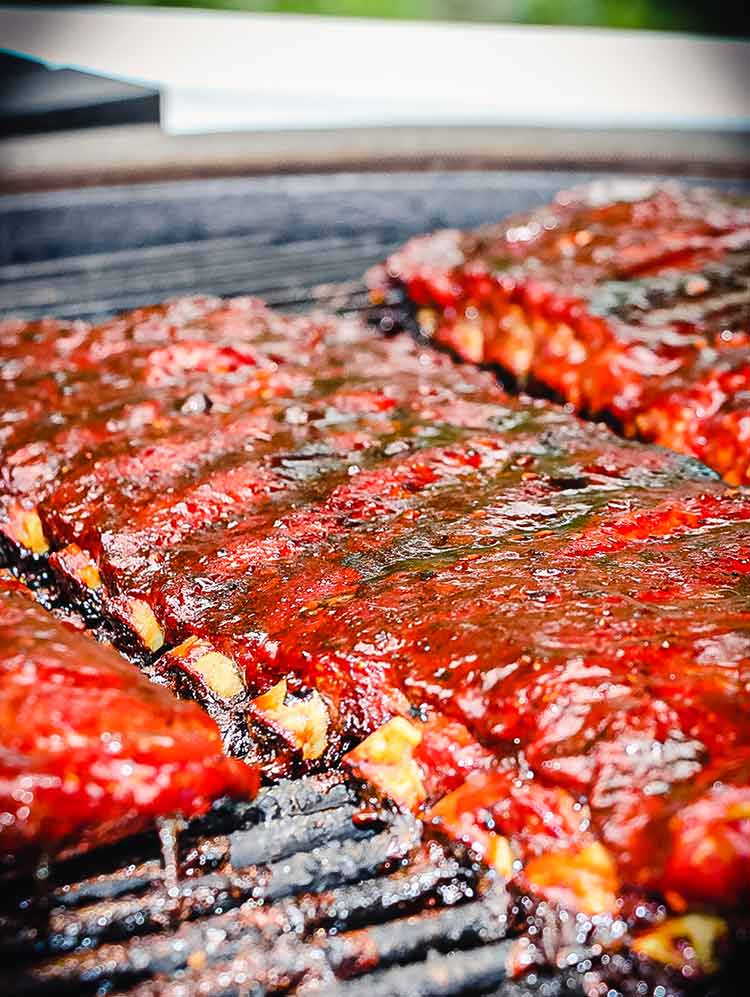
Another method is to bend the slab of ribs. The bend test is done with tongs or gloves and takes a little longer than just quickly looking at the bones, but it’s not hard. Simply pick up the slab and give it a slight bend towards a U shape.
If there is no separation or cracking between the ribs, they’re not ready. A slab of ribs that’s ready cracks easily between the bones and almost breaks in two.
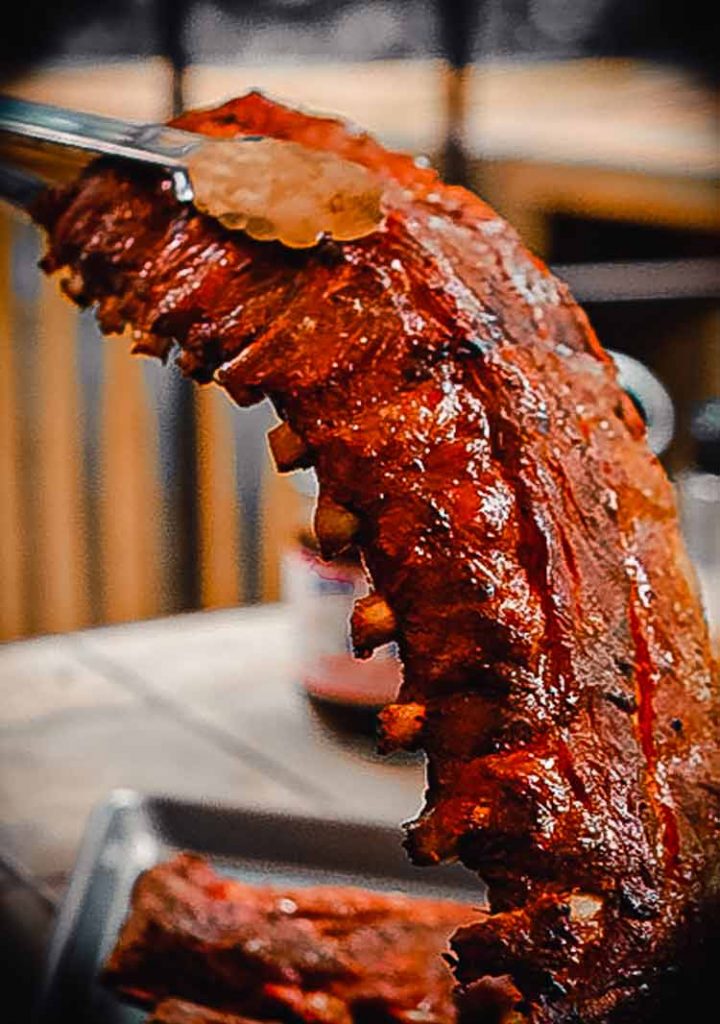
Many pit masters will use what’s called the toothpick test. If you have experience cooking a brisket, you’ll be familiar with this method.
I use the point of a temp probe needle and simply probe the meat in between the bones. You want there to be little resistance and for the probe to easily slide into the meat and come out cleanly.
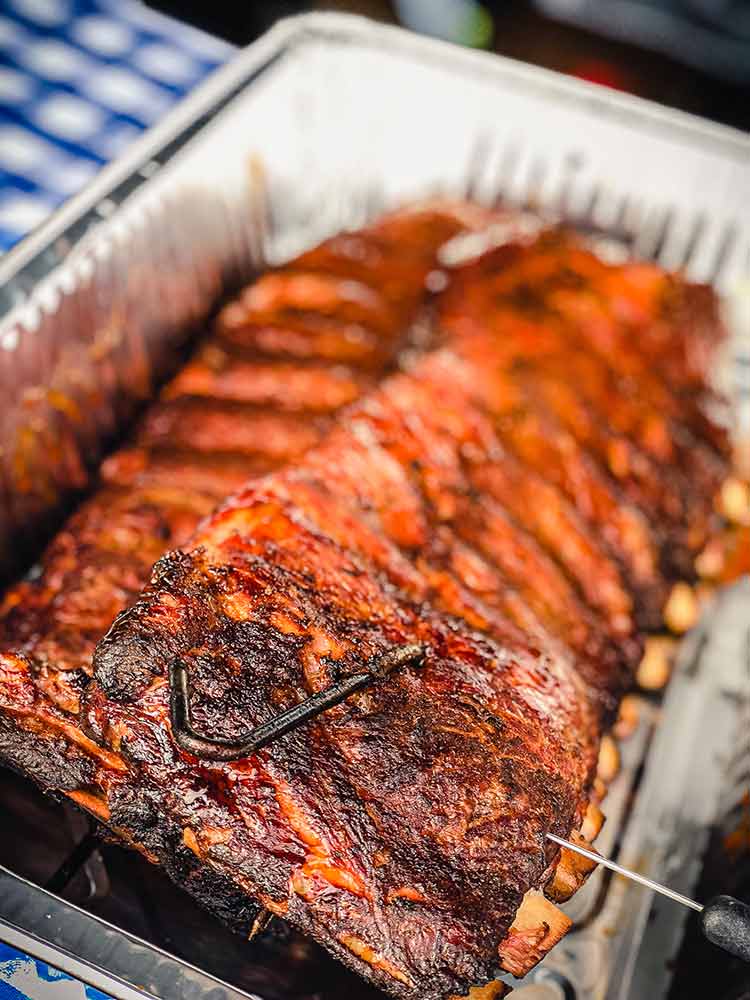
There are also ways like cutting into the ribs, twisting a bone, and not checking at all. So, some grillers only cook their ribs for a certain amount of time and then take them off the heat. I call this the “ready or not, here I come” method.
